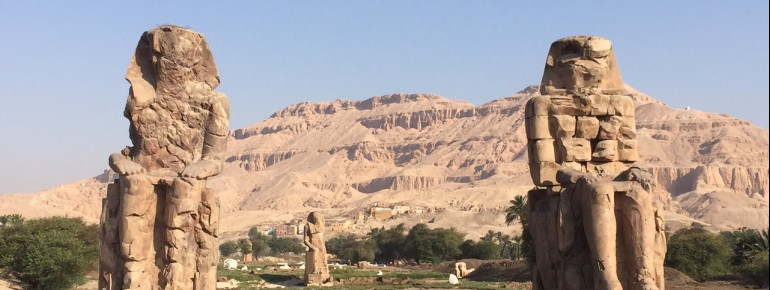Contents
Description
The Colossi of Memnon are two ancient Egyptian colossal statues from the 14th century BC. They are located near the Valley of the Kings in Thebes-West in the modern-day city of Luxor. Originally, the Colossi of Memnon stood in front of a pylon that marked the entrance to the temple of Amenophis III, a pharaoh of the 18th dynasty of the New Kingdom.
Structure of the Colossi of Memnon
The two quartzite colossi depict King Amenophis III sitting on a throne with his hands on his knees. There are smaller female figures on his legs. The figure on the right leg probably depicts Amenhotep's wife Teje, while the figure on the left leg shows his mother Mutemwia. A daughter of the pharaoh was probably depicted between the legs. Depictions of God and ancient Egyptian hieroglyphics are depicted on the sides of the throne.
Monumental dimensions
Today, the statues including the pedestals are still around 18 meters high. Originally, the height with the crown on the pharaoh's head was around 21 meters. The feet were each about two meters long and one meter wide. During Napoleon's Egyptian expedition, attempts were made to determine the weight of the Colossi of Memnon. It was calculated that the southern statue weighed around 750 tons and the pedestal another 556 tons. More recent investigations from the 1970s came to 720 tons for the statue and 500 tons for the pedestal.
Historical Information
The Temple of Amenhotep III
Pharaoh Amenhotep III was the father of Akhenaten, who went down in history as the so-called “heretic king” because he wanted to abolish Egyptian mythology and establish a monotheistic belief in the sun god Aton. Amenophis III ruled the New Kingdom during the first half of the 14th century BC. His two colossal statues were erected in 1379 BC and marked the entrance to a mortuary and memorial temple that extended behind the statues over a length of 700 meters and a width of 550 meters. The annual flooding of the Nile caused the mud bricks of the temple to disintegrate completely within a short period of time.
Decay of the temple complex
By the time of Pharaoh Merenptah at the beginning of the 13th century BC, a large part of the temple had already been completely destroyed. The pharaoh continued to use the rest for his own mortuary temple. There are several theories as to why the quartz statues are also badly damaged: One is that the invasion of Egypt by the Achaemenid king Cambyses II, which took place in 525 BC, was responsible. On the other hand, an earthquake in 27 BC is said to be one of the causes.
How the Colossi of Memnon got their name
The Colossi of Memnon only got their name in Greco-Roman times. Memnon was king of the Ethiopians. Upper Egypt, the part of the country where Thebes and Luxor are located, was once part of Ethiopia. According to Greek legend, Memnon, who was regarded by the Greeks as the son of Eos, the goddess of dawn, greeted his mother every morning at sunrise with a wailing cry. The northern colossus contains several cracks that run from the pharaoh's head to his waist. At sunrise, these cracks produce peculiar sounds that were associated with the wailing of Memnon. The two colossi were a popular destination for Greek and Roman travelers in particular, as it was believed to bring good luck to hear the wailing of Memnon. However, after the Roman Emperor Septimius Severus had the northern statue restored in 199 AD, the mystical sounds came to an end. However, the name of the statues remains to this day.
How to get there
The Memnon Colossi are located directly on the road leading to the mortuary temple of Hatshepsut. Tourist groups usually make a short stopover here when they are traveling by coach to the Valley of the Kings or the Temple of Hatshepsut. Visiting the sights in Thebes West on your own and without a knowledgeable tour guide is hardly worthwhile due to the lack of background information.



